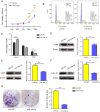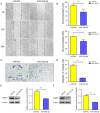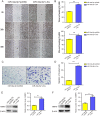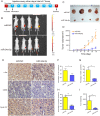miR-34a-5p inhibits the malignant progression of KSHV-infected SH-SY5Y cells by targeting c-fos
- PMID: 35444864
- PMCID: PMC9014853
- DOI: 10.7717/peerj.13233
miR-34a-5p inhibits the malignant progression of KSHV-infected SH-SY5Y cells by targeting c-fos
Abstract
Background: We aimed to investigate the effects of miR-34a-5p on c-fos regulation mediating the malignant behaviors of SH-SY5Y cells infected with Kaposi's sarcoma-associated herpesvirus (KSHV).
Methods: The KSHV-infected (SK-RG) and uninfected SH-SY5Y parent cells were compared for differentially expressed miRNAs using transcriptome sequencing. Then miR-34a-5p was upregulated in SK-RG cells by the miRNA mimics transfection. Cell proliferation ability was determined by MTT and plate clone assays. The cell cycle was assessed by flow cytometry analysis, and CDK4, CDK6, cyclin D1 levels were determined by Western blot analysis. The migration behavior was detected by wound healing and transwell assays. The protein levels of MMP2 and MMP9 were measured by Western blot analysis. The regulation of c-fos by miR-34a-5p was detected by the dual-luciferase reporter gene assay. Rescue assays were carried out by upregulating c-fos in miR-34a-5p-overexpressing SK-RG cells. KSHV DNA copy numbers and relative virus gene expressions were detected. Xenograft tumor experiments and immunohistochemistry assays were further used to detect the effects of miR-34a-5p.
Results: miR-34a-5p was lower in SK-RG cells. Restoration of miR-34a-5p decreased cell proliferation and migration, leading to a G1 cell cycle arrest and down-regulation of CDK4/6, cyclin D1, MMP2, MMP9. KSHV copy number and expression of virus gene including latency-associated nuclear antigen (LANA), replication and transcription activator (RTA), open reading frame (K8.1), and KSHV G protein-coupled receptor (v-GPCR) were also reduced. Furthermore, c-fos is the target of miR-34a-5p, while enhanced c-fos weakened cellular behaviors of miR-34a-5p-overexpressing cells. Xenograft experiments and immunohistochemistry assays showed that miR-34a-5p inhibited tumor growth and virus gene expression.
Conclusion: Upregulated miR-34a-5p in KSHV-infected SH-SY5Y cells suppressed cell proliferation and migration through down-regulating c-fos. miR-34a-5p was a candidate molecular drug for KSHV-infected neuronal cells.
Keywords: Kaposi’s sarcoma–associated herpesvirus; Migration; Proliferation; c-fos; miR-34a-5p.
© 2022 Wu et al.
Conflict of interest statement
The authors declare that they have no competing interests.
Figures








Similar articles
-
An Essential Role of c-Fos in Notch1-mediated Promotion of Proliferation of KSHV-Infected SH-SY5Y Cells.Curr Mol Pharmacol. 2024;17:e18761429264583. doi: 10.2174/0118761429264583231106104202. Curr Mol Pharmacol. 2024. Update in: Curr Mol Pharmacol. 2024;17:e051124236081. doi: 10.2174/187446721701241105144436. PMID: 38258595 Updated.
-
Kaposi's sarcoma-associated herpesvirus infection promotes proliferation of SH-SY5Y cells by the Notch signaling pathway.Cancer Cell Int. 2021 Oct 30;21(1):577. doi: 10.1186/s12935-021-02269-0. Cancer Cell Int. 2021. PMID: 34717617 Free PMC article.
-
Parthenolide inhibits proliferation of cells infected with Kaposi's sarcoma-associated herpesvirus by suppression of the NF-κB signaling pathway.Arch Virol. 2023 Jan 7;168(2):39. doi: 10.1007/s00705-022-05626-0. Arch Virol. 2023. PMID: 36609933
-
Regulation of the MIR155 host gene in physiological and pathological processes.Gene. 2013 Dec 10;532(1):1-12. doi: 10.1016/j.gene.2012.12.009. Epub 2012 Dec 14. Gene. 2013. PMID: 23246696 Review.
-
KSHV miRNAs decrease expression of lytic genes in latently infected PEL and endothelial cells by targeting host transcription factors.Viruses. 2014 Oct 23;6(10):4005-23. doi: 10.3390/v6104005. Viruses. 2014. PMID: 25341664 Free PMC article. Review.
Cited by
-
Effects and mechanisms of puerarin against neuroblastoma: insights from bioinformatics and in vitro experiments.BMC Complement Med Ther. 2024 Jul 9;24(1):257. doi: 10.1186/s12906-024-04569-0. BMC Complement Med Ther. 2024. PMID: 38982456 Free PMC article.
-
Lentinan suppresses the progression of neuroblastoma by inhibiting FOS-mediated transcription activation of VRK1 to stabilize p53 protein.Cell Death Discov. 2025 Mar 15;11(1):103. doi: 10.1038/s41420-025-02315-0. Cell Death Discov. 2025. PMID: 40089488 Free PMC article.
-
Folate-Targeted Nanocarriers Co-Deliver Ganciclovir and miR-34a-5p for Combined Anti-KSHV Therapy.Int J Mol Sci. 2024 Mar 2;25(5):2932. doi: 10.3390/ijms25052932. Int J Mol Sci. 2024. PMID: 38474177 Free PMC article.
-
Targeted delivery of miR-34a-5p by phenylborate-coupled polyethylenimide nanocarriers for anti-KSHV treatment.Front Bioeng Biotechnol. 2024 Jan 8;11:1343956. doi: 10.3389/fbioe.2023.1343956. eCollection 2023. Front Bioeng Biotechnol. 2024. PMID: 38260739 Free PMC article.
-
Overexpression of FOS enhances the malignant potential of eutopic endometrial stromal cells in patients with endometriosis‑associated ovarian cancer.Oncol Rep. 2025 Apr;53(4):45. doi: 10.3892/or.2025.8878. Epub 2025 Feb 21. Oncol Rep. 2025. PMID: 39981914 Free PMC article.
References
Publication types
MeSH terms
Substances
LinkOut - more resources
Full Text Sources
Medical
Research Materials
Miscellaneous

